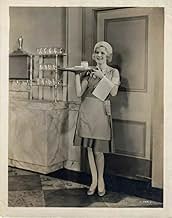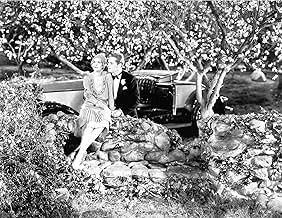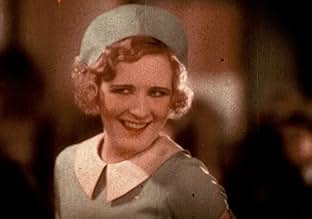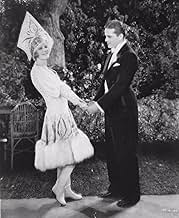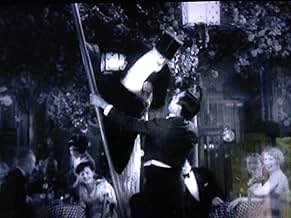Aggiungi una trama nella tua linguaSally was an orphan who got her name from the telephone exchange where she was abandoned as a baby. In the orphanage, she discovered the joy of dancing. Working as a waitress, she goes from ... Leggi tuttoSally was an orphan who got her name from the telephone exchange where she was abandoned as a baby. In the orphanage, she discovered the joy of dancing. Working as a waitress, she goes from job to job until she finds a job that also allows her to dance. At the restaurant, she mee... Leggi tuttoSally was an orphan who got her name from the telephone exchange where she was abandoned as a baby. In the orphanage, she discovered the joy of dancing. Working as a waitress, she goes from job to job until she finds a job that also allows her to dance. At the restaurant, she meets Blair and they fall for each other, but Blair is engaged to Marcia. Sally is hired to i... Leggi tutto
- Regia
- Sceneggiatura
- Star
- Candidato a 1 Oscar
- 1 vittoria e 1 candidatura in totale
- Undetermined Role
- (non citato nei titoli originali)
- Cafe Customer
- (non citato nei titoli originali)
- Chorus Girl
- (non citato nei titoli originali)
- Party Guest
- (non citato nei titoli originali)
- Cafe Customer
- (non citato nei titoli originali)
- Girls in dance number
- (non citato nei titoli originali)
Recensioni in evidenza
The story is adapted from the Ziegfeld show of the same name. It is about Sally Green (Marilyn Miller), an orphaned girl who waitresses and cooks in a diner for a living, but dreams of being a professional dancer. In fact, the very first shots of the film are of Miller's feet as she dances while she works. She also has an admirer (Alexander Grey) who stares at her from outside the café where she works, causing her to get so enthralled in his gaze one day that she inadvertently makes the world's largest pancake. Sally is basically a Cinderella story, and a charming one at that. There is no evil stepmother in this fairy tale, however, so you can just sit back and enjoy this light romantic comedy and its beautiful musical numbers. The romance is provided by Alexander Gray and Marilyn Miller, and the comedy is mainly provided by Joe E. Brown. Brown plays a prince made penniless by a revolution in his country of origin who now works at the restaurant with Sally and is also her good friend. One of the most delightful scenes in the film is where the two dance to "Look for the Silver Lining" with Miller doing her more formal interpretation alongside Brown's eccentric dancing.
Someone else compared Marilyn Miller to Irene Dunne, and there is one scene where that is particularly true. An agent has a famous dancer client who has run out on him the night before she is to perform at a big society party. Sally helps him out by impersonating that dancer complete with a ridiculous accent and an outlandish headdress. This comedy bit very much reminded me of something Irene Dunne would do.
The film was originally shot in two-strip Technicolor, but only one color scene still exists. That one scene is Miller dancing to "Wild Rose" at a society party, and the colors there are truly splendid. As soon as the Technicolor kicks in, for some reason, so does a higher quality level on the sound. Highly recommended for the fans of the early talkie musicals.
A few years ago, Turner Entertainment released the remains of what's left of a primitive early talkie called SALLY. SALLY was a legendary stage show first produced by Ziegfeld in 1919, representing Miss Miller's greatest triumphs. In 1929, she was given the opportunity to preserve her performance in this oversized adaptation.
The entire film was shot and released in 2-color Technicolor, and this process apparently had the by-product of enhancing the range of the sound.
The film is undeniably dated. It lacks rhythm that later films would quickly master. What is thrilling and fascinating is to watch this great star, Marilyn Miller, in action. Her greatest asset was her dancing, though even that wobbly voice has its charms.
The film is in woeful need of restoration. That said, it is pretty much all there. Provided the viewer is able to make the leap of faith in understanding that it a technological dinosaur, you can settle in and luxuriate in witnessing something like an authentic classic Ziegfeld show.
Supporting her is a very young Joe E Brown (best known as Captain Andy in the third film version of Show Boat) who is a lot of fun, and Alexander Gray, who like many other leading men of the early talkies is a bit of a stuffed shirt. You'll also spot the Keystone Kops' Ford Sterling as 'Pops'.
'Sally' is a hugely enjoyable early talkie. The colour sequence is lovely and bright - it is a pity that we lose the impact from the rest of the film. The songs are good and Miss Miller is a treat to watch. Try to catch this when it next airs on TCM.
In 1929 she made "Sally" for First National (forerunner of Warner Bros.) in which she recreated one of her stage triumphs. It is good and with some competent back-up supporting actors, but I would say it is an incomplete document if one is trying to 'discover' Marilyn Miller. The story is familiar, about a waitress looking for her big show biz break with a romantic side-story, and she shows her star appeal as a passable singer, a better actress and an even better dancer. She is pretty in a familiar sort of way, but she wins you over with her vivacious, cheerful demeanor.
The website rating is about right, and you get the feeling that being captured on film in an unremarkable story doesn't do her justice. I haven't seen her other films but I am reasonably certain that they do not capture the full impact of this legendary performer, either. I guess we'll just have to rely on historical sources and those three films.
Sally appears to be a bit dated, as we make our way through this new millennium, but serves as a tribute to the beauty and youth of Marilyn Miller. Miller is a fantastic dancer and gives the role 100%.
The film is hard to find, but worth watching if you locate it. Thanks to MGM/UA and Turner for finding the merit to release it on laser disc back in 1993.
Lo sapevi?
- QuizOriginally presented in 100% two-color Technicolor, at present the complete film survives only in black and white, with a singular musical number, "Wild Rose," in color.
- Citazioni
Otis Hooper: [to 'Connie', the waiter] I have 10 bucks - and only 10 bucks.
[opens the menu]
Otis Hooper: What would you suggest?
'Connie': Another restaurant.
- ConnessioniFeatured in Broadway: The American Musical (2004)
- Colonne sonoreSally
(1920) (uncredited)
Music by Jerome Kern
Lyrics by Clifford Grey
Played during the opening credits and often in the score
Sung by Alexander Gray and Chorus
Danced by Marilyn Miller and Joe E. Brown
Danced by Miller and Albertina Rasch Dancers at the follies
I più visti
Dettagli
Botteghino
- Budget
- 647.000 USD (previsto)
- Tempo di esecuzione1 ora 43 minuti


